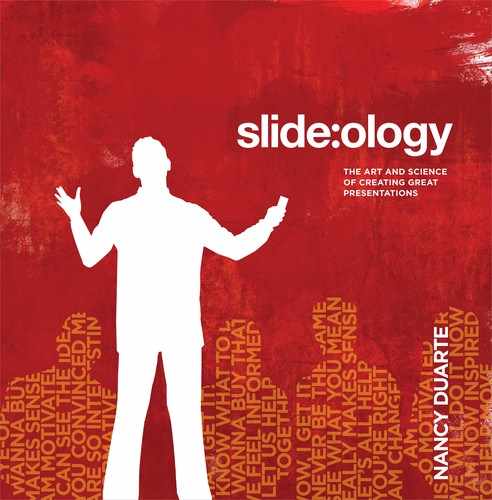
206 slide:ology
Making Template Design Decisions
Rarely Change
Logo
Signage
Template-driven systems
Business systems (letterhead)
Website framework
Brochure templates
Datasheets
Visual attributes
Color palettes
Grid layouts
Fonts
Graphical elements
Build a template that is timeless so that
you won’t tire of it easily. If built well, it can
remain in circulation for years.
When a large company transitions to a new template, the
process can take a Herculean effort that tanks productivity,
at least temporarily. The best way to avoid having to re-
create the template every time there’s an inspiring new ad
campaign or marketing whim is to focus on the timeless
components of your brand or industry. Those elements are
the visual attributes of the brand that rarely, if ever, change.
At right are the brand attributes that evolve versus those
that remain relatively unchanged. Don’t make design deci-
sions that will expire in the short term, or base your decisions
on a short-term campaign.
Look through all the material that your company produces
and identify the elements that are purely decorative versus
those that are the truly essential visual brand elements. For
the template, use the essential elements only.
Remember, the template is just that, a template. It should
be a basic shell for your words and images. It shouldn’t be
a stand-alone work of art.
Often Transform
Ad campaigns
Marketing campaigns
Retail displays and packaging
Annual reports
1
2
3
4
1
2
3
4
Governing with Templates 207
You need to determine what should go in a template, com-
pared to what should go on the slide. To do that, you’ll need
to identify the varying types of content that your company
uses to convey its messages. One approach is to collect files
from many departments, audit them, determine communica-
tion patterns, and then build a template that meets the com-
munication needs of each organization appropriately.
The effective use of a template helps viewers become accus-
tomed to where the content will appear on a slide and give
them a sense that slide content is structured and aligned.
Content should not bounce from slide to slide. There’s nothing
more frustrating than having content jump around so much
that each slide becomes a puzzle that takes some study to
figure out where to start processing information. Titles and
bullet copy should appear in the same locations (unless you’ve
intentionally designed it that way to serve a purpose). By set-
ting the placement and divisions of space for your corporate
power-users, they will be able to recognize (and value) the
underlying skeletal structure, the reasoning used to develop
the template, and the rationale for them to use the template.
T!P
Believe it or not, before you start developing a
template, a conversation with your IT department
is in order.
• Ask the IT department what the migration plan
is for the company’s presentation application.
If the company is close to a major upgrade, get
that beta and begin a strategy on how to build a
template in the newest release of the application.
• If you create a template loaded with images,
query the IT department whether the organization
has adequate storage. Presentation files procre-
ate like bunnies, and a 1MB template might seem
innocent, but it can add up to terabytes in a single
department in a month.
..................Content has been hidden....................
You can't read the all page of ebook, please click here login for view all page.
